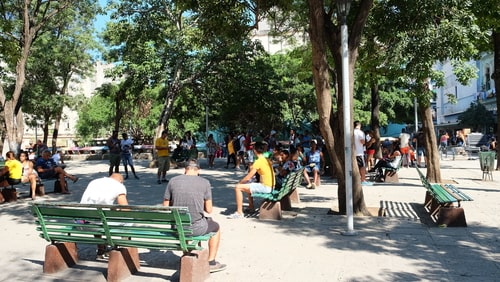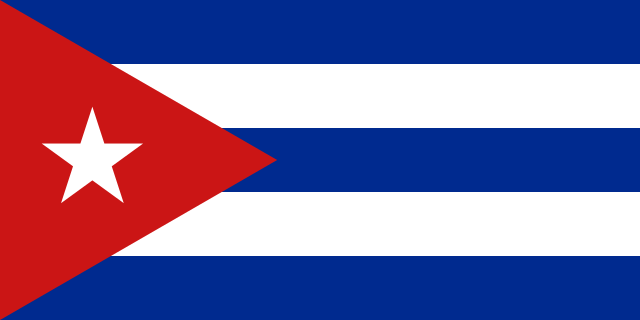Last updated on September 29th, 2022
46. On April 18, 2018, Miguel Diaz-Canel Bermudez became the president of Cuba with the stepping down of the former president Raul Castro.[17]
47. In 2017, an estimated 4.7 million tourists rolled into Cuba. President Barack Obama authorized individual people to people travel, which resulted in an influx of U.S travelers to the island nation. However, after the announcement of new regulations in June 2017 by the Trump administration, there was a noticeable drop-off in U.S. travelers to Cuba. He restricted the ability of Americans to travel to Cuba as tourists. Tourism is one of the main sources of revenue for the island.[18]
48. Gay marriages in Cuba are legal (since 27 September 2022) after the National assembly signed off on a document which describes marriage as “consensual union of two people, regardless of gender.”
49. Cuba has nine properties inscribed on the UNESCO World Heritage List. Seven of these are cultural while two are natural.[20]
50. In 1886, Slavery was abolished in Cuba.[21]
51. According to the Economic Complexity Index (ECI), In 2020, Cuba was the 151th largest export economy in the world. China, Spain, Germany, and Indonesia are some of the top export destinations of Cuba; while Brazil, Algeria, China, Spain, and Mexico are some of the top import origins for Cuba.[29]
52. Between 1959 and 2011, sale of property in Cuba was banned. However, Cuba is set to recognize private property under a new constitution which is yet to take effect.[23]
53. Did you know that the Castro brothers, first Fidel and them Raul, ruled the country between 1959 and 2018?[23]
54. The U.S. embassy in Havana which recently reopened sits empty to this day because of the recent incidents with the U.S. diplomats who reported an unexplained medical condition that left some with hearing loss or mild brain damage. Interestingly, no cause for the ailments has been found in more than a year of investigation by the FBI and other U.S. and Cuban authorities. Reports suggest that at least 2 dozen employees were withdrawn from the embassy last year. Some sources have referred to these occurrences as “sonic attacks.” Similar incidences of these attacks were reported by the U.S. diplomats in China as well.[24,26]

55. The first-ever public Wi-Fi hotspots were opened in Cuba in 2015. However, some usage fee for accessing the internet was also levied from the users.[25]
About the flag of Cuba

Cuba, the largest Caribbean island, boasts a flag that represents the true identity of its residents, particularly the passion they demonstrated for independence.
It is a tri-color flag featuring a five-pointed white star inside a red triangle on the hoist (left side).
The right side has five alternating horizontal stripes- blue (3) and white (2).
Below are more insightful facts about the flag of Cuba, from history, design, meaning, and uses.
History and Origin of the Cuban Flag
Having survived over 100 years, including Spanish wars and political revolutions, the flag of Cuba has a long, fascinating history. However, it made a debut 50 years before its official launch, whereby soldiers would carry it in battles.
One of the patriots, Narciso Lopez, used the flag in 1850 at Cárdenas as a spearhead of the independence movement and the following year at Playitas.
Though his troops lost the battles, his efforts contributed to what became the official flag of Cuba. It is the same flag that Jose Marti used throughout the Cuban revolution and 1892.
The origin of the Cuban flag can be traced to New York City, where a group of Cubans lived in exile because they were against Spanish rule back at home.
That is why its design shares elements of the American flag, such as stripes, stars, and three colors.
The Cuban flag was designed in 1849 and officially embraced on 20th May 1902, when the island country gained independence.
But before its official adoption, Cuba flew the American flag starting 1st January 1899 when the U.S.A liberated the country from the Spanish colony.
Design by Two Patriots
The Cuban flag is regarded as a lone star or ‘la Estrella solitaria’ in the native language.
Its design was a combined effort of two gentlemen. Narciso Lopez, a pro-independence Venezuelan freedom fighter who led Cubans in exile, conceived the first flag idea.
While in New York City, Narciso López dreamed about a free Cuba. He suddenly woke up, looked through the window, and saw red clouds that formed a triangle. He saw Venus in the middle of the clouds that spread to form two white bands across the blue morning sky.
Then, Miguel Teurbe Tolón, a Cuban poet, created a lone star flag and the final product. Lopez urged his followers to embrace Tolon’s design as it added more dimension to his initial concept.
Symbolism
Cuban flag colors are very emotive to Cuban patriots, with the two white stripes expressing independence from the United States. They also symbolize Spanish dominance. The lone star was a famous emblem among patriotic leaders, including Fidel Castro. It is associated with the Cuban revolution and speaks volumes about what it took to gain freedom.
When the Republic of Cuba was declared independent, the colors and design of the flag gained new meanings. The blue stripes stand for the old regions of the island, while the red triangle was the blood spilled during the fight for independence. On the other hand, a five-pointed white star denotes freedom and equality.
It is worth noting that The Cuban flag is strikingly similar to that of Puerto Rico. However, the Cuban flag is older, while the Puerto Rican flag draws inspiration from France. Since Cuba and Puerto Rico are close, they share some cultural norms and almost the same histories and origins.
The flag of the Republic of Cuba is flown in all institutions and during important occasions like national holidays and sporting events.
Cuba – country at a glance
| Country name | conventional long form: Republic of Cuba conventional short form: Cuba local long form: República de Cuba local short form: Cuba |
|---|---|
| Etymology | name derives from the Taino Indian designation for the island "coabana" meaning "great place" |
| Independence day | 20 May 1902 (from Spain 10 December 1898; administered by the US from 1898 to 1902); not acknowledged by the Cuban Government as a day of independence |
| Capital City | Havana (23°8′N 82°23′W) |
| Largest City | Havana (23°8′N 82°23′W) |
| Government type | communist state |
| Literacy rate | 99.7% |
| Total area | total : 110,860 sq km land: 109,820 sq km water: 1,040 sq km (slightly smaller than Pennsylvania) |
| Location | Caribbean, island between the Caribbean Sea and the North Atlantic Ocean, 150 km south of Key West, Florida |
| Land boundaries | 28.5 km |
| Population | 10,932,679 (2025 est.) |
| Demonym | Cuban |
| National Anthem | "La Bayamesa" (The Bayamo Song) |
| National symbol | royal palm |
| National colors | red, white, blue |
| Prime Minister | Manuel Marrero Cruz |
| Official Language | Spanish |
| Borders | Jamaica, Haiti, Bahamas, and Florida Keys. |
| Coastline | 3,735 km |
| Currency | Peso |
| Religion | nominally Roman Catholic 85%, Protestant, Jehovah's Witnesses, Jewish, Santeria |
| Life expectancy at birth | 80.1 years (2024 est.) |
| Suffrage | 16 years of age; universal |
| Terrain | mostly flat to rolling plains, with rugged hills and mountains in the southeast |
| Mean elevation | 108 m |
| Lowest point | Caribbean Sea 0 m |
| Highest point | Pico Turquino 1,974 m |
| Climate | tropical; moderated by trade winds; dry season (November to April); rainy season (May to October) |
| Natural resources | cobalt, nickel, iron ore, chromium, copper, salt, timber, silica, petroleum, arable land |
| Agricultural land | 60.3% |
| Birth rate | 9.9 births/1,000 population (2024 est.) |
| Death rate | 9.5 deaths/1,000 population (2024 est.) |
| Sex ratio | 0.99 male(s)/female (2024 est.) |
| Industries | petroleum, nickel, cobalt, pharmaceuticals, tobacco, construction, steel, cement, agricultural machinery, sugar |
| Exports | $8.769 billion (2020 est.) tobacco, nickel, zinc ore, liquor, raw sugar (2022) |
| Imports | $8.067 billion (2020 est.) poultry, wheat, milk, plastic products, soybean oil (2022) |
| GDP - per capita (PPP) | $13,128 (2022 est.) |
| Internet country code | .cu |
| Time Zone | CST (UTC−5) |
| Calling Code | +53 |
| Drives on the | Right |
| Table last updated | August 08, 2025 |
